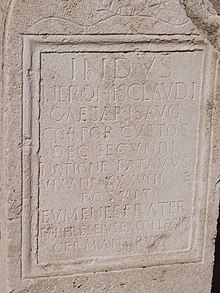| Politics of ancient Rome |
|---|
 |
| Periods |
|
| Constitution |
| Political institutions |
| Assemblies |
| Ordinary magistrates |
| Extraordinary magistrates |
| Public law |
| Senatus consultum ultimum |
| Titles and honours |

The Numerus Batavorum, also called the cohors Germanorum, Germani corporis custodes, Germani corpore custodes, Imperial German Bodyguard or Germanic bodyguard, was a personal, imperial guards unit for the Roman emperors of the Julio-Claudian dynasty (30 BC – AD 68) composed of Germanic soldiers. Although the Praetorians may be considered the Roman emperor's main bodyguard, the Germanic bodyguards were a unit of more personal guards recruited from distant parts of the Empire, so they had no political or personal connections with Rome or the provinces.
From Commentarii de Bello Gallico, it is known that Julius Caesar also had a Germanic bodyguard.
Overview
The members of the Numerus Batavorum were recruited from the Germanic tribes resident in, or on the borders of, the Roman province of Germania Inferior, with most recruits drawn from the Batavi but also from neighbouring tribes of the Rhine delta region, including the Frisii, Baetasii and Ubii. Little is known about their organization; the 500 bodyguards were formed up in five centuries, each century commanded by a centurion. From inscriptions it is known that there existed, as in all Roman cavalry units, the officer rank of decurion. The exact size of the unit, which was at least partially mounted, is also unknown, but is described in ancient sources as a cohort, which in this period normally implied a strength of 500 men or less, similar to a numerus, whose size could vary. Under the Emperor Caligula, the Bodyguard may have consisted of 500 to 1,000 men.
The Germanic Cohort was valued as loyal and reliable. Emperors like Nero trusted the Germani especially because they were not of Roman origin.
The guard was disbanded briefly after the Battle of the Teutoburg Forest, and was finally dissolved by Galba in 68 because of its loyalty to Nero (ruled 54–68), whom he had overthrown. The decision caused deep offense to the Batavi, and contributed to the outbreak of the Revolt of the Batavi in the following year. Their indirect successors were the Equites singulares Augusti which were, likewise, mainly recruited from the Germani. They were apparently so similar to the Julio-Claudians' earlier Germanic Bodyguard that they were given the same nickname, the "Batavi".
Herod the Great, a client king of Judea, had a Germanic bodyguard modeled upon that of Augustus.
See also
- Leibgarde
- Imperial Roman army
- The Varangian Guard, which was the revived form of the Numerus Batavorum, serving in the period from under the Eastern emperor Basil II and culminating in the 1204 Sack of Constantinople.
References
- National Museum of Rome, Baths of Diocletian, Rome. Inscription: AE 1952, 148: Indus / Neronis Claudi / Caesaris Aug(usti) / corpor(is) custos / dec(uria) Secundi / natione Batavus / vix(it) ann(os) XXXVI h(ic) s(itus) e(st) / posuit / Eumenes frater / et heres eius ex collegio / Germanorum "Indus, bodyguard of Nero Claudius Caesar Augustus, of the Second Decuria, of the Batavian nation, lived 36 years, is buried here. was erected by his brother and heir, Eumenes, from the collegium of the Germanic tribesmen".
- Suetonius, Caligula 43.
- ^ Suetonius, Galba 12.
- Suetonius, Caligula 58, 3 and inscriptions, e. g. AE 1952, 148.
- CIL VI 4340, 4342, 4343, 4437, 21068; AE (1976) 750, (1923) 73
- Rankov 1994, p. 5. sfn error: no target: CITEREFRankov1994 (help)
- Grünewald & Schalles 2001, p. 97. sfn error: no target: CITEREFGrünewald_&_Schalles2001 (help)
- Webster, Graham (1985). The Roman Imperial Army of the First and Second Centuries A.D., Black, London/Oklahoma, p. 101. ISBN 0-8061-3000-8.
- Caesar, de bello Gallico 7, 13, 1.
- Roymans, Nico (2000). Germania inferior (ed. Newald and Schalles), Walter de Gruyter, Berlin. ISBN 3-11-016969-X. p. 97(in English)
- CIL VI 8802, 8803, 8804, 8807; AE (1952) 146, 147, 148, 149, (1968) 32
- CIL VI 4342, VI 4343
- CIL VI 8808
- CIL VI 8809
- Roymans (2000), p. 258.
- Alexandra W. Busch: Militär in Rom. Militärische und paramilitärische Einheiten im kaiserzeitlichen Stadtbild (= Palilia Vol. 20). Reichert, Wiesbaden 2011, ISBN 3-89500-706-4, Die Unterkunft der Germani corporis custodes, p. 94
- Suetonius, Galba 12: multisque experimentis fidelissimam.
- Tacitus, Annals 15, 58: Germanis, quibus fidebat princeps quasi externis.
- Suetonius, Augustus, 49.1
- Tacitus Hist. II.5
- Fuhrmann, Christopher J. (2012). Policing the Roman Empire: Soldiers, Administration, and Public Order, OUP, New York, pp 128/129. ISBN 978-0-19-973784-0
- Rocca, Samuel (2009). The Army of Herod the Great. Osprey Publishing. pp. 15–16. ISBN 978-1-8460-3206-6. Retrieved 8 March 2014.
Further reading
- Ross Cowan: Roman Guardsman 62 BC - AD 324 (Oxford 2014)
- Michael P. Speidel: Germani Corporis Custodes. In: Germania 62, 1984, pp. 31–34 (not evaluated). (in German)
- Oliver Stoll: Leibwache. In: Reallexikon der Germanischen Altertumskunde. 2. Aufl. Bd. 18. Berlin: Walter de Gruyer, 2001, p. 232-233 ISBN 3-11-016950-9
External links
- Die germanische Leibgarde der julisch-claudischen Kaiser ("The Germanic Bodyguard of the Julio-Claudian Emperors") at kriegsreisende.de.
